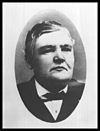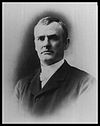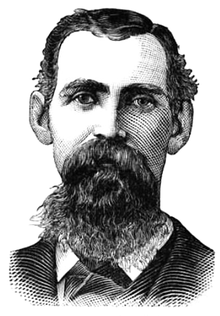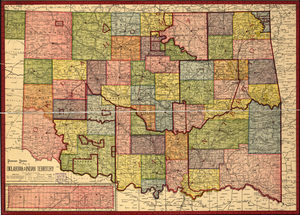- Oklahoma Territory
-
Coordinates: 35°24′N 97°00′W / 35.4°N 97°W
Territory of Oklahoma Organized incorporated territory of the United States ← 
1890–1907  →
→Capital Guthrie Government Organized incorporated territory Governor List History - Organic act May 2 1890 - Statehood November 16 1907 The Territory of Oklahoma was an organized incorporated territory of the United States that existed from May 2, 1890, until November 16, 1907, when it was joined with the Indian Territory under a new constitution and admitted to the Union as the State of Oklahoma.
Contents
History
Organization
Oklahoma Territory's history began with the Indian Intercourse Act of 1834 when the United States Congress set aside land for Native Americans. At the time, the land was unorganized territory that consisted of all the federal land "west of the Mississippi and not within the states of Missouri and Louisiana, or the territory of Arkansas..." By 1856, the territory had been reduced to the modern-day borders of the State of Oklahoma. These lands quickly became known as Indian Territory, as they had been granted to certain Indian nations under the Indian Removal Act, in exchange for their historic territories east of the Mississippi River.
Up until this point, Native Americans had exclusively used the land. In 1866, after the American Civil War, the federal government required new treaties with the tribes that had supported the Confederacy, and forced them into land and other concessions. The Five Civilized Tribes were required to emancipate their slaves and offer them full citizenship in the tribes if they wanted to stay in the Nations. This forced many of the tribes in Indian Territory into making concessions. The US officials forced the cession of some 2,000,000 acres (8,100 km2) of land in the center of the Indian Nation Territory.
The popular press began referring to this tract as the Unassigned Lands or Oklahoma and to the people agitating for its settlement as Boomers. To prevent settlement of the land by European Americans, in April 1879, President Rutherford B. Hayes, issued a proclamation forbidding unlawful entry into Indian Territory.
David Payne and the Boomers
Despite federal obstruction, popular demands for the land did not end. Captain David L. Payne was one of the main supporters of the opening of Oklahoma to white settlement. Payne traveled to Kansas, where he founded the Boomer "Colonial Association." Payne's organization hoped to establish a white colony in the Unassigned Lands and included 10,000 members. The formation of the group prompted President Hayes, on February 12, 1880, to issue a proclamation ordering Payne not to enter Indian Territory. In response, Payne and his group traveled to Camp Alice in the Unassigned Lands, east of Oklahoma City. There, they made plans for a city, which they named "Ewing." The Fourth Cavalry arrested them, took them to Ft. Reno and escorted them back to Kansas. Payne was furious, as public law (see Posse Comitatus Act) prohibited the military from interfering in civil matters. Payne and his party were freed—effectively denying them access to the courts.
Anxious to prove his case in court, Payne and a larger group returned to Ewing in July. The Army again arrested the party and escorted them back to Kansas. Again they were freed but this time the federal government charged Payne with trespassing under the Indian Intercourse Act; he went to trial in Ft. Smith, Arkansas. Judge Isaac Parker ruled against Payne and fined him the maximum amount of one thousand dollars. Since Payne had no money and no property, the fine could not be collected. The ruling settled nothing as to the question of the public domain lands, and Payne continued his activities.
Payne tried a third time to enter the Unassigned Lands. In December, Payne and his group moved along the northern border of Indian Territory. They were followed by a unit of cavalry under the command of Colonel J.J. Copinger. Colonel Copinger warned Payne that if he crossed the border that they would be "forcibly resisted." As the number of Boomers grew as people joined Payne, they sent a messenger to President Hayes asking permission to enter Indian Territory. After weeks of no response, Payne led his followers to the Unassigned Lands. Once again, they were arrested and Payne was sent back to Fort Smith. He was found guilty and sentenced to pay a $1,000 fine. Upon his release, he returned to Kansas, where he spent the next four years trying to open Oklahoma.
During Payne's last venture, this time into the Cherokee Outlet in 1884, the Army again arrested him. They took him several hundred miles under severe physical circumstances over a tortuous route to Ft. Smith. The public was outraged about his treatment by the military, and the US government decided to try his case. Payne was turned over to the United States District Court at Topeka, Kansas. In the fall term, Judge Cassius G. Foster quashed the indictments and ruled that settling on the Unassigned Lands was not a criminal offense. The Boomers celebrated, but the federal government refused to accept the decision.
Payne immediately planned another expedition, but he would not lead it. On November 28, 1884, in Wellington, Kansas, the morning after a late-night address to the Boomers, he collapsed and died.
William Couch and the Opening
After Payne's death, his associate William L. Couch assumed the leadership role. Couch, in December 1884, moved the Boomers into Indian Territory and founded Camp Stillwater on December 12, 1884. President James Garfield sent a small detachment of troops to escort Couch out of the Territory. When the soldiers arrived, 200 armed men met them and refused to be moved. After 600 troops arrived as reinforcements, the officers gave the Boomers of leaving within 48 hours or being attacked. After the Boomers refused to leave, the commanders moved their troops across the Kansas border and cut off Couch's supply lines. Soon, their food was gone, and Couch and the other Boomers were escorted back to Kansas.
In response to Couch's claims that the federal government was discriminating against them, on March 3, 1885, Congress approved the Indian Appropriations Act of 1885. This act authorized negations for the cession of unoccupied lands belonging to the Creek Indians, the Seminole Indians, and the Cherokee Indians. Couch stopped being a colonist and became a lobbyist.
Couch would spend four years in Washington, D.C. trying to convince Congress to open Oklahoma. Many Indians from the Five Civilized Tribes lobbied against Couch's actions. In January 1889, Pleasant Porter led a group of Creek who offered to sell their unoccupied lands. Within weeks, they sold their Unassigned Lands to the United States. These Unassigned Lands embraced less than 3,000,000 acres (12,000 km2) in the heart of Indian Territory.
On March 2, 1889, Congress passed an amendment with the Indian Appropriations Act of 1889, which provided for the opening of homesteading settlements in Unassigned Lands, to be known as Oklahoma. President Benjamin Harrison announced that Oklahoma would be opened on April 22 via land run. The land run was to be held at noon and was open to all people of at least 21 years of age.
Land Run and the Sooners
The Land Run of 1889, the first land run in the territory's history, opened Oklahoma Territory to settlement on April 22, 1889. Over 50,000 people entered the lands on the first day, among them several thousand freedmen and descendants of slaves. Couch and his Boomers, now numbering some 14,000, also entered the race. Those who entered Oklahoma before the official start of the race were called Sooners.
When the run began at noon, men on thousands of horses, wagons, buggies, carts, and vehicles rushed across to Oklahoma. The law-abiders fought with the Sooners on several instances. A legal pioneer shot and wounded William Couch, a Sooner. He died on April 21, 1890, as a result of his wounds.
When the race was over, many disappointed pioneers were forced to leave the area without any claim. Of the 14,000 Boomers, only 1,000 had made claims. Tent cities grew overnight at Oklahoma City, Kingfisher, El Reno, Norman, Guthrie, and Stillwater, which was the first of the settlements.
Early Territorial Period
The brief legislation that provided for the opening of the land called for no form of government in Oklahoma. No local police or courts were established; federal military troops provided law enforcement and the United States District Court for the Western District of Arkansas under federal judge Isaac Parker was the only form of criminal and civil jurisdictions. Despite that, the district was generally peaceful. Most land disputes were settled without bloodshed, although a few took years to resolve. For over a year the people of Oklahoma Territory were semi-autonomous. The only government during this period was that created and maintained by common consent, yet there was no lawlessness or outlawry, and property and life were adequately protected at all times.
The next year, on May 2, 1890, Congress passed the Oklahoma Organic Act, which organized the western half of Indian Territory into Oklahoma Territory. The eastern half remained under Indian rule, predominantly that of the Five Civilized Tribes, as Indian Territory. Congress included in Oklahoma Territory the strip of country known as No Man's Land, embracing 3,681,000 acres (14,900 km2), which became Beaver County. In September 1890, the 1,282,434 acres (5,189.83 km2) of the Sac and Fox, Iowa, and Pottawatomie reservations in the eastern part of Oklahoma Territory were opened to settlement. The following spring, the 4,397,771 acres (17,797.15 km2) of Cheyenne and Arapaho lands in the center of the Territory were opened. On September 16, 1893, the Cherokee Outlet was opened to settlement, and the counties of Kay, Grant, Woods, Woodward, Garfield, Noble, and Pawnee were created from its 6,014,239 acres (24,338.76 km2) of land. In 1895 the Kickapoo reservation of 206,662 acres (836.33 km2) was settled, and the year following Greer County, which had been considered a portion of Texas, was given to the Territory by a decision of the Supreme Court of the United States. All of these, with the Kiowa, Comanche and Apache and Wichita reservations just opened, gave Oklahoma Territory a settled area of 24,000,000 acres (97,000 km2), 1,725,646 acres (6,983.44 km2) of which was still included in Indian reservations.
Path to Statehood
Oklahoma Territory existed from 1890 to 1907. During that time, seven Governors (and two acting Governors) administered the territory. During its 17-year existence, little of note occurred due to the growing idea of statehood, which had originated in Indian Territory. Most of the Governors stayed in office for only a few months; institutions founded during this time were the University of Oklahoma, the University of Central Oklahoma (then known as the Territorial Normal School) and the Oklahoma State University (then known as Oklahoma Agricultural and Mechanical School). The territory's real purpose was to serve as a transitional government from unorganized territory to state.
Representatives of the Five Civilized Tribes met in 1902 to work on securing statehood for Indian Territory and held a convention in Eufaula. The representatives met again in 1903 to organize a constitutional convention.
The Sequoyah Constitutional Convention met in Muskogee, on August 21, 1905. General Pleasant Porter, Principal Chief of the Creek Nation, was elected as president of the convention. The elected delegates decided that the executive officers of the Five Civilized Tribes would be appointed as vice-presidents: William C. Rogers, Principal Chief of the Cherokees; William H. Murray, appointed by Chickasaw Governor Douglas H. Johnston to represent the Chickasaw; Chief Green McCurtain of the Choctaw; Chief John Brown of the Seminole; and Charles N. Haskell, appointed by Porter to represent the Creek.
The convention drafted a constitution, drew up a plan of organization for the government, put together a map showing the counties to be established, and elected delegates to go to the United States Congress to petition for statehood. The convention's proposals were presented in a referendum in Indian Territory, in which they were overwhelmingly endorsed.
The delegation received a cool reception in Washington. Eastern politicians, fearing the admission of two more Western states, put pressure on the U.S. President, Theodore Roosevelt. He ruled that the Indian and Oklahoma Territories would be granted statehood only as a combined state.
The hard work of the Sequoyah State Constitutional Convention was not entirely lost. When representatives from Indian Territory joined the Oklahoma State Constitutional Convention in Guthrie the next year, they brought their constitutional experience with them. The Sequoyah Constitution served in large part as the basis for the constitution of the State of Oklahoma, which came into being with the merger of the two territories in 1907.
Territorial Governor Frank Frantz oversaw the transition from territory to state. He was selected as the Republican nominee to serve as the state's first Governor. He faced the Democratic Charles N. Haskell in the election on September 17, 1907. In the same election, the Oklahoma Constitution was proposed. The Constitution was passed and Haskell was elected Governor. Once the people of Oklahoma adopted the United States Constitution on November 16, 1907, Oklahoma and Indian Territories officially dissolved and the State of Oklahoma was admitted to the Union as the 46th state.
Government
With the passage of the Oklahoma Organic Act, in June 1890, the territorial government came into existence. The territorial government had no constitution, except for sections of the Organic Act creating it, which served as a semi-governing document. The Organic Act provided for a complete organization of the Territory, defined the functions of the territorial government, placed limitations upon the acts of the legislative assembly, as well as that of the territorial officers.
Congress provided for the creation of a legislative branch elected by the people, but the executive and judicial branches of the territories were selected and appointed by the President of the United States, with the advice and consent of the United States Senate.
Legislative branch
The Organic Act called for the establishment of a bicameral Territorial Legislative Assembly, to be composed of a thirteen member Territorial Council, the upper house of the Assembly, and twenty-six member Territorial House of Representatives, the lower house of the Assembly. The Organic Act allowed the Assembly to increase its membership (up to eighteen in the Council and thirty-six in the House of Representative) if the number of qualified voters increased by a proportionate amount. Territorial Councilors served staggered two-year terms, with half being elected every year. Territorial Representatives served one-year terms, with all Representatives being elected every year.
The Assembly's legislative power extended to all rightful subjects of legislation, as long as the laws enacted were consistent with the Constitution of the United States and the Organic Act. Acts passed by the Assembly did not require the consent of Congress to take effect. They had the same force of law, as did a law passed by a regular state government. All law enacted by the Assembly took effect upon their final passage and approval. However, any law could be suspended by the President of the United States or revoked, in part or in its entirely, by an act of Congress.
When the first Territorial Governor George Washington Steele took office, he issued an executive order on July 8, 1890, calling for the first elections to the Assembly. The date set for this election was August 5, 1890. The Assembly was to have convened August 12, but owing to the death of two members-elect a special election was called and the convening of the legislature was postponed until August 27, 1890.
Executive Branch
The executive branch consisted of the Governor of Oklahoma Territory, a Territorial Secretary, a Territorial Attorney and a Territorial Marshal. All of whom were appointed by the President of the United States, with the consent of the Senate, to serve a four-year term, unless sooner removed by the President.
The Governor was vested with the executive power of the Territory, was responsible for ensuring that all laws were faithfully executive, and served as the symbol of the federal government in the Territory. The Governor was the ex officio commander-in-chief of the Territory's militia and the federal troops in the Territory as well as ex officio Superintendent of Indian Affairs. The Governor possessed the power to grant pardons for offenses against the laws of the Territory. He also could grant reprieves for offenses against the laws of the United States until the President made his decision on the matter. It was also the duty of the Governor to outline the boundaries of the counties, name the county seats, and to appoint all Territorial and county officers with the consent of the Territorial Council.
All laws passed by the Territorial Assembly had to be presented to the Governor for his approval. If he did not approve, he would veto if and return it to the Assembly for reconsideration. The Governor's veto could only be overridden by a two-thirds vote of both the Territorial Council and Territorial House of Representatives. The Governor also had the right to convene the Assembly into special session.
The Secretary would serve as the chief assistant to the Governor and, in the event of a vacancy of the Governorship; the Secretary would serve as the Acting Governor until a new one could be appointed by the President. The Secretary was responsible for recording and preserving all laws and proceedings of the Assembly and all the acts and proceedings of the Governor. Copy of the same would semi-annually be submitted to the President, the President of the United States Senate and the Speaker of the United States House of Representatives for their review.
The Territorial Attorney was responsible for giving legal advice to the Governor and Assembly as well as serving as the chief law enforcement official of the Territory. It was the duty of the Attorney to represent the Territory and the United States in all court cases in which either were involved. The Territorial Marshall was responsible for protecting the court system and for executing all processes issued from the Territorial courts.
Judicial branch
The Judiciary was the Territorial Supreme Court, consisting of three Justices: one Chief Justice and two Associate Justices. The Supreme Court was given a wide jurisdiction. It functioned, not only as a United States Federal Court, but its jurisdiction extended to a trial of all cases (both civil law and criminal law) arising under the code enacted by the Territorial Legislature. The Court could sit half of the day as a Federal Court and the other half as Territorial Court. It would also serve as a supreme court and hear cases that had been appealed from Territory's lower courts.
Federal representation
The Territory was entitled to elect one Delegate to the United States House of Representatives to serve a two-year term. While unable to vote in the full House, the Delegate was allowed to vote in a House committee of which the Delegate is a member.
List of Governors
# Name Took Office Left Office Party Appointed By Photo 1 George Washington Steele 1890 1891 Republican Benjamin Harrison - Robert Martin 1891 1892 Republican none (acting governor) 2 Abraham Jefferson Seay 1892 1893 Republican Benjamin Harrison 
3 William Cary Renfrow 1893 1897 Democratic Grover Cleveland 
4 Cassius McDonald Barnes 1897 1901 Republican William McKinley 
5 William Miller Jenkins 1901 1901 Republican William McKinley 
- William C. Grimes 1901 1901 Republican none (acting governor) 6 Thompson Benton Ferguson 1901 1906 Republican Theodore Roosevelt 
7 Frank Frantz 1906 1907 Republican Theodore Roosevelt 
Lands that came to make up Oklahoma Territory
- Old Oklahoma – April, 22, 1889 – opened by land run.
- No Man's Land – May 2, 1890, assigned to Oklahoma Territory by Organic Act.
- Iowa reserve – September 22, 1891 – opened by land run.
- Sac and Fox reserve – September 22, 1891 – opened by land run.
- Tonkawa reserve – 1891 – allotment.
- Citizen Potawatomi and Absentee Shawnee reserve – September 22, 1891 – opened by land run.
- Cheyenne Arapaho reserve – April 19, 1892 – opened by land run.
- Cherokee Outlet – September 17, 1893 – opened by land run.
- Kickapoo reserve – May 4, 1896 – opened by land run.
- Greer County – March 16, 1896 – officially assigned to Oklahoma Territory (Supreme Court decision May 23, 1895, separated the county from Texas).
- Comanche, Kiowa, and Apache reserve – June 9 through August 6, 1901 – lottery.
- Wichita and Caddo reserve – June 9 through August 6, 1901 – lottery.
- Ponca and Otoe–Misouria reserve – 1904 – allotment.
- Kaw reserve – 1906 – allotment.
- Osage reserve – 1906 – allotment.
- Big Pasture – December 1906 – sealed bid.
See also
- American Civil War, 1861–1865
- Compromise of 1850
- Historic regions of the United States
- History of Oklahoma
- Mexican-American War, 1846–1848
- Territorial evolution of the United States
- Territories of Spain that encompassed land that would later become part of the Territory of Oklahoma:
- Nueva Vizcaya, 1562–1821
- Santa Fé de Nuevo Méjico, 1598–1821
- Tejas, 1690–1821
- Luisiana, 1764–1803
- Territory of France that encompassed land that would later become part of the Territory of Oklahoma:
- Louisiane, 1682–1764 and 1803
- Territory of Mexico that encompassed land that would later become part of the Territory of Oklahoma:
- Santa Fé de Nuevo México, 1824–1848
- Territorial claim of the Republic of Texas, 1836–1845
- U.S. territories that encompassed land that would later become part of the Territory of Oklahoma:
- Louisiana Purchase, 1803–1804
- District of Louisiana, 1804–1805
- Territory of Louisiana, 1805–1812
- Territory of Missouri, 1812–1821
- Adams-Onís Treaty of 1819
- Indian territory, 1834–1907
- former territorial claim of the Republic of Texas, 1845–1850
- Mexican Cession, 1848
- No Man's Land, 1850-1890 (ungoverned)
- Cimarron Territory, 1886-1891 (extralegal)
- U.S. state created from the Territory of Oklahoma and the final extent of the Indian territory:
- State of Oklahoma, 1907
- Territories of Spain that encompassed land that would later become part of the Territory of Oklahoma:
References
External links
 History of OklahomaLouisiana Purchase · Indian removal · Indian Territory · Civil War · Oklahoma Territory · State of Sequoyah · State of OklahomaCategories:
History of OklahomaLouisiana Purchase · Indian removal · Indian Territory · Civil War · Oklahoma Territory · State of Sequoyah · State of OklahomaCategories:- States and territories established in 1890
- States and territories disestablished in 1907
- Oklahoma Territory
Wikimedia Foundation. 2010.




